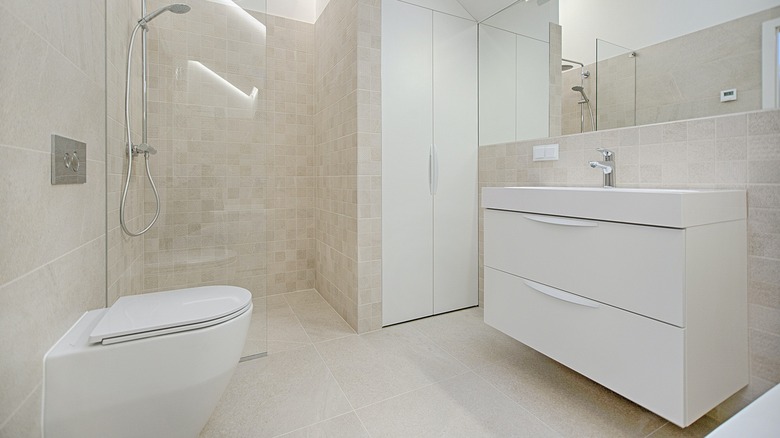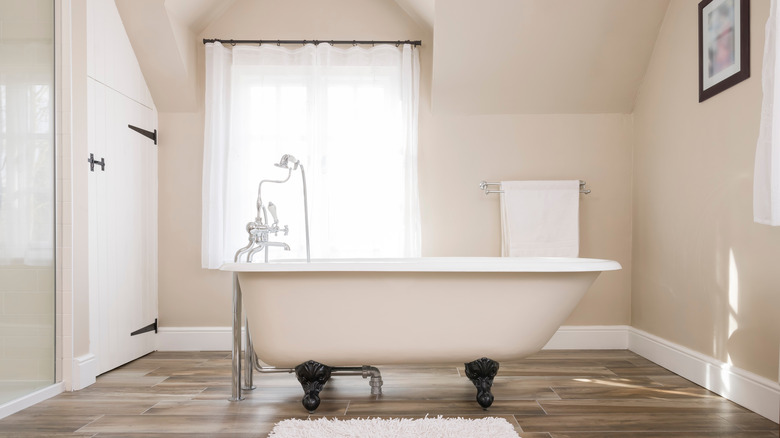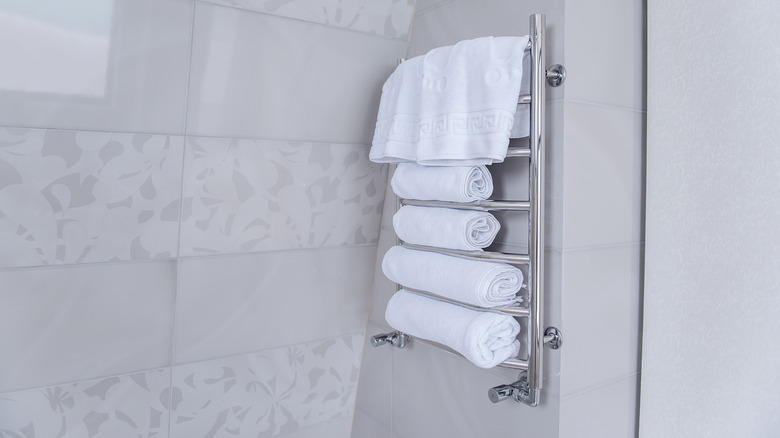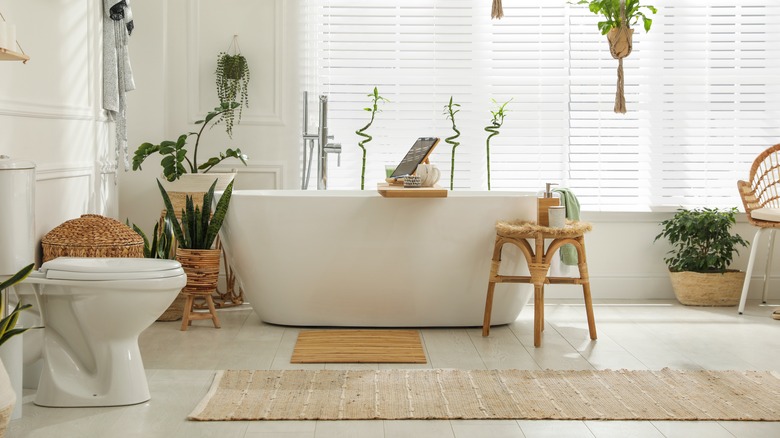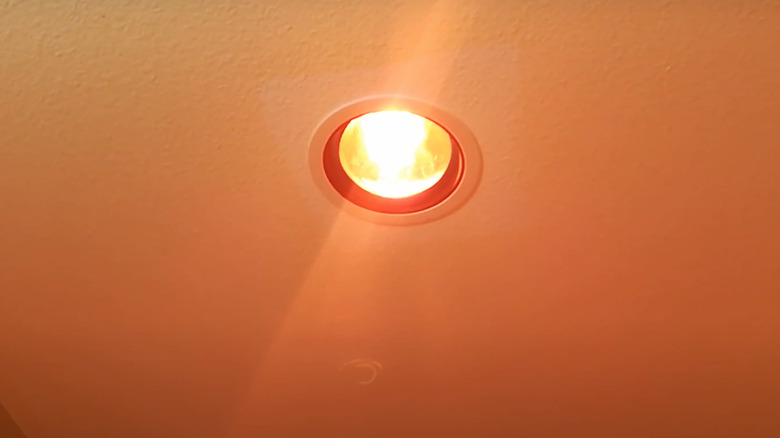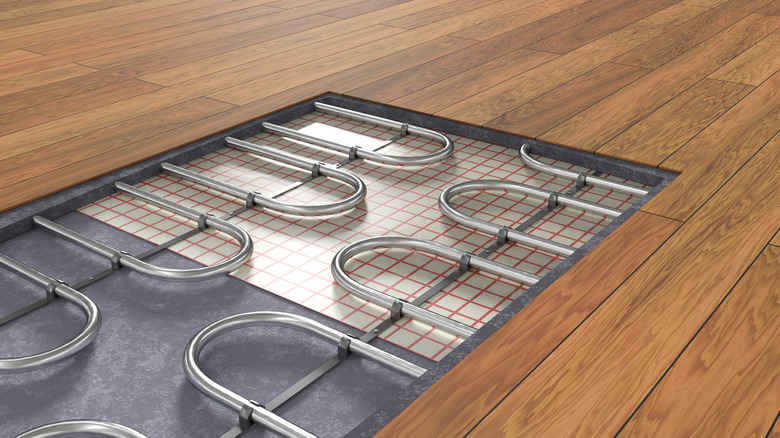5 Simple Ways To Keep Your Bathroom Warm This Winter
We all hate the feeling of stepping out of a hot shower into a cold bathroom and feeling every inch of our body shiver. However, as the temperatures continue to drop outside, we must ensure that this fact doesn't impact our daily activities indoors. It's already hard enough to roll out of our warm bed in the morning; a cold bathroom is just going to make it even more difficult.
There are many reasons your bathroom is cold during the winter months especially, and one is the type of tiles you use. Porcelain is a great choice for bathroom floors because they are resilient against water but on the other hand, they are very cold to step on, per Viessmann. Warm rooms typically have cozier finishes, such as drapery, carpet, and throw pillows; however, what works in other areas of your home may become moldy in this space due to the humidity it harbors. So, we've found a few options to warm up the washroom for those who desire a cozy bathroom experience.
1. Check your windows
According to Steam Shower Parts, your windows may be the main reason why your bathroom gets so cold during the winter. Any small gaps can cause cold air to flow in while allowing warm air to get out. If you're suspicious of your windows, touch all around the glass and window frames to feel for any air movement. Drafts are typically found around the edges and wherever parts of the window cross over.
If you notice any cool air flowing in, you should quickly caulk the edges and get some weather strip to cover the areas that cross each other. If you currently have weather strips on the windows but they've become old and flimsy, make sure to replace them as well. WCMA Net also recommends applying a removable, transparent plastic window film over all your bathroom windows if you have insulation concerns. Another insulation method is installing lined curtains or heavy blinds to keep the warm air inside.
2. Install a towel warmer
The unpleasant cold shivers when walking out of the steamed shower can easily be prevented by installing a towel warmer in the bathroom. This device is capable of keeping our towels and robes warm while we bathe and creates a daily spa-like experience as we step out to wrap ourselves with something that feels like warm sunshine, Only Towel Warmers & Bidets describes. Another benefit of towel warmers is that you won't have to constantly smell mildewed towels because the appliance also has the ability to dry them quickly.
The average cost of a towel warmer can be pricey, but it varies depending on whether you install it yourself or call in a professional, according to Costimates. If you do it yourself, the cost could be around $255. However, if you hire a professional, the price can get to a little over $600. On the bright side, there are various types of towel warmers at different prices to accommodate most budgets, so all you need to do is research the market a bit to find one that your funds can cover.
3. Add a few colorful rugs
Bathroom floors are typically made of tile and stone, which are both beautiful options, but they can be cold to step on during those chilly winter months. Laying down area rugs onto your washroom floor won't just keep your feet warm, but it can also protect your flooring material, elevate your bathroom décor, and hide any stains or damage, according to RugKnots. An area rug can also visually make your bathroom look warmer; if this space has a lot of square footage, it's advised to obtain a large area rug with an interesting pattern to create a sense of warmth and interest.
However, make sure the material your rug is made of is suitable for the bathroom. For example, according to Silver Rug Cleaning, polyester ones are great options for humid and highly utilized environments because they are durable and can handle constant foot traffic. Nylon rugs are also good options because they are also lasting and are often more slip resistant than alternatives made of other materials.
4. Get an infrared bulb
A heat lamp may do the trick if you've been outside in the cold all day and need a wave of warmth. An infrared heat lamp uses a certain type of incandescent light bulb, and its main purpose is to produce heat rather than light, according to BathroomHeater. This product's benefit is that it is usually energy efficient and uses minimal power to heat up a space. This device is meant to be used when needed only and should not be left on all day.
BathroomHeater says heat lamps are usually installed on the ceiling and are better at warming up a specific spot rather than the whole space. So, it's advised to choose a placement in the bathroom where you stand the most as a location for your heat lamp. We advise you place it above the vanity, as this is where you most likely conduct your daily bathroom routines. This device is an affordable warming option for washrooms, as the price of a bulb is usually about $5 to $15.
5. Warm up your toes
We advise installing heated flooring if you really want to go all out and keep your toes toasty all winter. Not only will it make your entire bathroom feel warmer, but the system is also very durable, with a lifespan of at least 35 years, according to MacDonald Hardwoods. It can also be a big energy saver because you can keep the thermostat down while enjoying the warmth emitted through the flooring.
MacDonald Hardwoods says you also don't have to worry about burning your feet because all radiant heat models usually have some sort of safety measure in place to prevent injury. This is also a beneficial product if you plan to sell your home because it can increase its value, the company's site notes. On the other hand, the upfront costs can be pretty high. The average cost is $10 to $12 per square foot, so a total bathroom floor renovation cost could be anywhere between $590 and $833, depending on the type of system you choose and the size of your space (via WarmlyYours).
